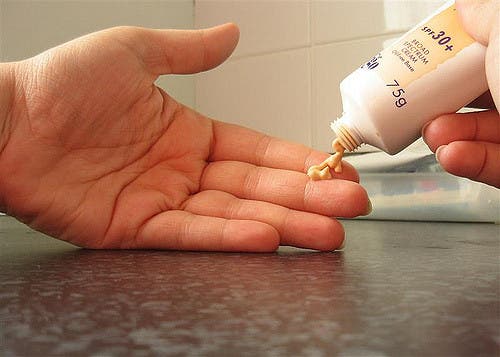Women who use certain sunscreens might be at risk of infertility, as scientists found 45 percent of the tested products contained chemicals that mess with the function of sperm. It’s important to note that this research is still ongoing. Tests were made in vitro, using sperm cells in a solution that mimicked conditions inside the female fallopian tubes. Not even mice were tested yet, so take the findings with a grain of salt (i.e. don’t freak out just yet).

Image: Flickr
“These results are of concern and might explain in part why unexplained infertility is so prevalent,” said the study’s senior investigator, Niels Skakkebaek, MD, DMSc, a professor at the University of Copenhagen and a researcher at the Copenhagen University Hospital, Rigshospitalet.
Skakkebaek and colleagues studied 29 of the 31 UV filters allowed in sunscreens in the U.S. or the European Union (EU) on live sperm cells collected from healthy donors. The cells were placed in buffer solution.
The analysis was focused on calcium signaling, where changes in the concentrations of calcium ions causes the cell to behave differently. In sperm, this signaling is very important. CatSper is one of the most important calcium ion channels inside the human sperm cell. It’s the main receptor for progesterone, a hormone that attracts human sperm cells. When the hormone binds to the Catsper calcium channel, the interaction causes a temporary surge in calcium ions inside the sperm cell. This controls several sperm functions necessary for fertilization.
[MORE] What the SPF number on your sunscreen means
Researchers found 13 of 29 tested UV filters induced calcium ion influxes in the sperm cell. “This effect began at very low doses of the chemicals, below the levels of some UV filters found in people after whole-body application of sunscreens,” Skakkebaek said. Nine of the thirteen filters specifically cause calcium ion influx in the CatSper channel, thereby mimicking the effect of progesterone.
“Our study suggests that regulatory agencies should have a closer look at the effects of UV filters on fertility before approval,” said Skakkebaek, who has since applied for funding to test these findings in an animal model.
UV filters are used in sunscreens that protect the body by absorbing UV rays, instead of reflecting them. Physical sunscreens that contain reflecting chemicals like zinc shouldn’t interfere with sperm function — if there’s anything that’s interfering in the first place. We’ll know more for certain after research on mice is carried out.
Some of the filters found to disrupt sperm function are: avobenzone, homosalate, meradimate, octisalate (also known as octyl salicylate), octinoxate (or octyl methoxycinnamate), octocrylene, oxybenzone (also called benzophenone-3 or BP-3) and padimate O.
via Science Alert









